BEYOND HORIZON
By Andrew Maerkle
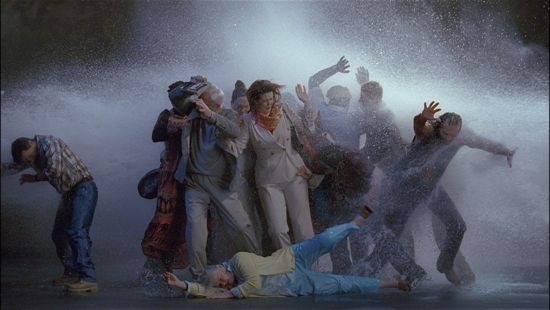
Tempest (Study for The Raft) (2005), color high-definition video on flat panel display mounted on wall, duration 16 min 50 sec, screen 109 x 66 x 10.2 cm. Performers: Sheryl Arenson, Robin Bonaccorsi, Rocky Capella, Cathy Chang, Liisa Cohen, Tad Coughenour, Tom Ficke, James Ford, Michael Irby, Simon Karimian, John Kim, Tanya Little, Mike Martinez, Petro Martirosian, Jeff Mosley, Gladys Peters, Maria Victoria, Kaye Wade, Kim Weild, Ellis Williams. Photo Kira Perov. All images: Courtesy Bill Viola Studio.
A pioneer of video art and multimedia installations, Bill Viola was recognized this year with one of the world’s most prestigious cultural distinctions, the Japan Art Association’s Praemium Imperiale culture prize. Although Viola’s works are often described as “moving paintings,” they engage with a broad set of concerns developing from both an interest in what motivates human behavior and expression, as well as from a consideration of the specifics of medium and place, and the relations between artwork and viewer. As much as they create memorable or even iconic images – images that could be paintings – Viola’s recent videos move in and out of time, extending an on-screen action for what can feel like an eternity through the use of slow motion, or dramatically redefining what at first appears to be an eternal image through the introduction of sudden, fleeting action, and it is often this aspect of the works – their use of images to facilitate a deep experience of time – that leaves the strongest impression on the viewer.
ART iT met with Viola to discuss his approach to art making in greater detail.
Interview:
ART iT: Your recent works seem to all follow a simple structure, with a single camera shooting from a fixed position in a continuous take. At the same time the consistency of your approach suggests that you are thinking about essential concerns of how images are constructed, and the relations between camera and subject. Is this a conscientious part of your recent practice?
BV: No, I’m not thinking at all about how images are constructed. What I’m most interested in is how human beings are constructed. I’m interested in how we perceive things in the world, how we interact with the world and how we are part of a larger whole that includes not only our own position in the world but also the mental states that we experience when we are confronted with things that we don’t exactly understand. Most of my work is about self-knowledge or self-awareness, and not so much about the outside point of view or the position of observation, which I consider to be a scientific position – going back to Descartes – that has no interest for me. I’m interested in what’s inside the self and how that manifests.
Certainly, if you look at my recent works – especially series like Ocean Without a Shore (2007), and “The Passions” from around 2000 – they seem to have a scientific basis. They are focused studies observing people behave in certain ways in controlled situations, which is in fact what I thought I was making at the time. But what I actually was doing was trying to understand the nature of our emotional selves.
For me, the best way to deal with that was to slow everything down so I could look carefully at what was happening, not with the idea of drawing any logical conclusions or making a statement the way Darwin did with his studies of human emotions [as in The Expression of the Emotions in Man and Animals (1872)], but rather so I could understand it from the point of view of performance, from the point of view of an internal motivation. What makes us act a certain way? What makes you assume the posture that you do now, which obviously must be comfortable for you but is not at all comfortable for me? This unconscious or subconscious sense of order, which is very different from a mental or intellectual order, greatly interests me.
I should add that from the beginning of 2000 all my work came out of the fact that I had just lost my father, while my mother passed away at the beginning of 1992. That changed everything, because I was so distraught. My work could no longer be about intellectual processes; it was about trying to stay alive.
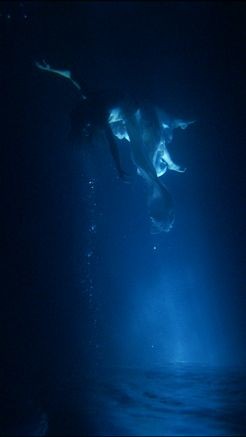
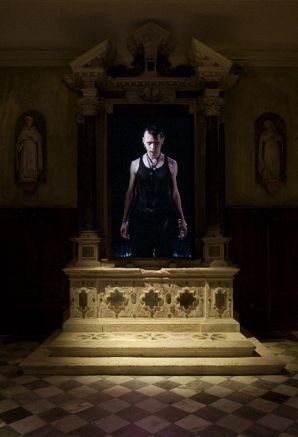
Left: Isolde’s Ascension (The Shape of Light in Space After Death) (2005), color high-definition video on plasma display mounted on wall, duration 10 min 30 sec, stereo sound, screen 155.5 x 92.5 x 12.7 cm. Performer: Sarah Steben. Photo Kira Perov. Right: Installation view of Ocean Without a Shore (2007) at San Gallo, Venice, high-definition color video triptych, two 65-in plasma screens, one 103-in screen mounted vertically, continuous running, six loudspeakers (three pairs stereo sound), room dimensions variable. Performers: Luis Accinelli, Helena Ballant, Melina Bielefelt, Eugenia Care, Liisa Cohen, Darrow Igus, Page Leong, Oguri, Larry Omaha, Jean Rhodes, Chuck Roseberry, Lenny Steinburg, Julia Vera, Blake Viola, Ellis Williams. Photo Mike Bruce.
ART iT: But works such as Isolde’s Ascension (The Shape of Light After Death) (2005) seem to engage in complex ways with elements of theatricality. Isolde’s Ascension begins with the illusory image of a blue, watery surface at the bottom of the monitor and a shifting, atmospheric expanse above. At first you’re not sure where the setting is. It could be outdoors, maybe by the sea, since there are indications of natural phenomena such as what appear to be mist and a horizon line, for example. Then the woman’s body splashes into the composition from below, sinking upward, and the orientation and scale of the image are radically inverted and compressed, everything moving in opposition to the laws of physics. It is this very moment when the illusion reaches its climax that the construction of the work is also revealed. We can piece together that it’s been filmed indoors, with a tank of water, and the camera has been placed upside down.
BV: Yes. I’ve been doing that most of my career. I have always been interested in doing the minimum manipulation possible to achieve the maximum effect. In that piece all I did was to turn the camera upside down, but because it’s in a pool and because it was lit a certain way, you think all sorts of things when it starts: is this the cosmos, or the sky? You don’t know what it is, and then you gradually learn as it unfolds, getting clues until you see the woman appear, and even then you’re not sure. I can’t tell you how many people have told me they didn’t realize the bubbles are going the wrong way, upside down. It shows how much we don’t see, or how much we take for granted in images.
I like that piece because it’s mysterious and you don’t really know where you are. Even when she enters the frame and she starts floating up, you still don’t understand that she’s actually sinking. All you have to do is take the monitor and turn it upside down, and then you’ll see what the real orientation is. I was doing that for quite a while, trying to challenge myself to make the smallest change for the maximum result. It was a little game I played with myself for quite a number of years. I don’t do it so much anymore.
ART iT: In contrast, your earliest works and installations seem to engage more directly with the technological aspects of video and its display. I’m sure being part of the first generation to use the medium necessitated a degree of reflexivity in terms of how you used it.
BV: That’s all I was after: reflexivity. The very first video I made that I considered a success was about understanding the nature of the self. The work is titled Tape I (1972), with the “I” in the title not referring to the Roman numeral, but rather I, as in myself. I set up a simple situation, placing a camera in a room with a mirror on the wall and a door behind, and I entered. At this point viewers of the video see a person entering a room and moving forward, but then something strange happens: all of a sudden the person appears in front of the screen and you realize you were seeing a mirror image the whole time. Then I sat down in a chair, looked straight ahead at the camera, and tried to focus my concentration on myself for as long as possible, until I could gather a scream as loud and as strong as I could, while trying to restrain it at the same time. So this video, the very first I ever made, combines this idea of reflexivity and self-knowledge with a complete release, a complete breaking and crashing through this image of the self in the mirror.
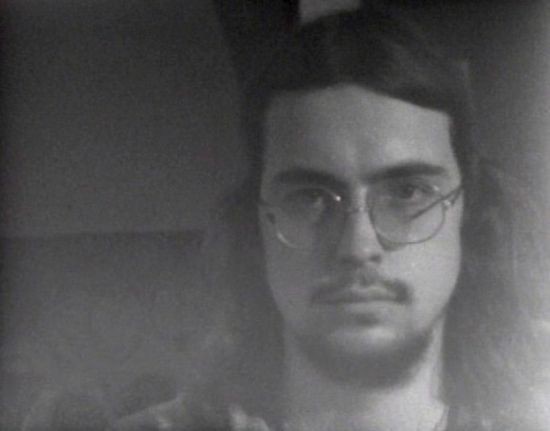
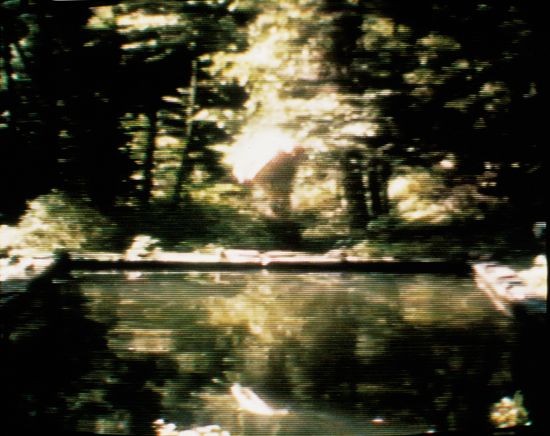
Top: Tape I (1972), videotape, black-and-white, mono sound, duration 6 min 50 sec. Produced at Synapse Video Center, Syracuse University, Syracuse, New York. Bottom: The Reflecting Pool (1977-79), videotape, color, mono sound, duration 7 min. Both: Photo Kira Perov.
ART iT: And this interest was intricately tied to exploring the medium itself?
BV: Yes. What video gave artists that we never really had before – more so than photography, even though video emerges from photography – was to make possible a real-time, simultaneous image of the self. You could see yourself not as a past image, as in photography, but as a present-tense image.
For many people that effect is very disturbing. Some of the pieces I made when I was younger could be very disturbing to people because they don’t like to look at themselves. They can do it with a photograph because it’s a fixed representation, but when they see themselves in video – in the moment – they might laugh, but it would be a nervous laughter. It isn’t a nice experience. Then they start to analyze themselves, thinking, “Do I really look like that?” Instead of becoming a nice document of one’s self, video introduces a disturbing, out-of-balance element.
ART iT: In terms of the relationship between technology and effect, another work that intrigues me is The Reflecting Pool (1977-79), for which in editing the video you manipulated different layers of time.
BV: The whole scene at that time with video was all about experimentation. People were constantly breaking new ground, which was both challenging and exciting. I participated in that, and wanted to contribute to it. In a way my early works were about portraiture: many of them were framed tight around head and shoulders, very clear and confrontational. I don’t like analyzing my own work, but you can’t help it as you get older and remember things, and the power of The Reflecting Pool was that it was the first piece that moved away from concerns of self-image by shifting the setting into nature.
At the time I didn’t even understand what I was doing. I’m telling you this now, but when it was happening, when I saw the pond in the woods and saw the reflections, I immediately knew that I wanted to work with it, without thinking it through at all. There was no intellectual process. I simply took the camera, found the right position, and knew I had to keep it fixed while shooting these scenes across two days, with views of the pond in the daytime and afternoon and evening light. It was an important breakthrough for me because it got me out of this narcissistic mode, which I think most young artists experience. This work moved me into nature, which hadn’t interested me to that point because to me nature was the classical landscape – the Dutch painters – and so old-fashioned that I wanted nothing to do with it. This piece also led me to work more with water, which has been a very important part of my life. So it was a starting point for a new way of working.
ART iT: Yet as you’ve come to look more at people as opposed to your self, it seems you’ve shifted back into the studio environment. What you mention about the controlled environments of “The Passions” struck me when I saw your work Tempest (Study for The Raft) (2005), in which you spray a group of people with powerful jets of water and film their reactions, many of which evoke historical depictions of anguish and supplication. Why couldn’t these people act out their responses, why was it necessary for them to be induced by the water? There’s no easy resolution to this question, because if you had them act, it might not be as convincing – although it would in a sense be a real performance – whereas spraying them with water produces strong reactions, but in a controlled environment such expressions become disingenuous. Which is more “genuine,” and which more referential?
BV: You’re opening up a real interesting set of issues, because who’s to say that even right now we are not acting? I think you and I are acting. If you leave and I stay here on my own, in a way I would still be acting, because I would be remembering what we were just discussing, and I would know where I am: I would be in a kind of scene.
This aspect of self-knowledge goes back to the myth of Narcissus, although in the Greek tradition it’s treated as a cautionary tale, in that he falls into the water and drowns. And the French theorists in recent years have been strongly concerned with questions of how real is real, what is reality and what is an illusion, what is pretend and what is truth. On the other hand, I wasn’t so interested in trying to resolve these issues as they manifest in post-modernist critique, which to me is analogous to police interrogation. When the police interrogate someone, they shine a light on the subject and demand to know all its secrets. For me, that’s not a valid way to create art. I’m not after anybody’s secrets. I’m involved in nature, in the world, in this moment, and I believe strongly in temporality and time-form.
People look at my work and see that I use slow motion, see these connections with historical representation, but I do not consider myself to be a visual artist. I’m a time artist. I developed my own version of time-form, creating graphs that are not about the visual part of the works at all but about the temporality of the works, which I used in making “The Passions.” That’s what I discovered in dealing with my father’s death, which was the end of time as I knew it, as a son. I realized that we live in time the way fish live in water: we can’t see it, we can’t taste or touch it, but it’s an integral part of our lives. Most people are not aware of this, just as a fish does not know what water is. Instead of going deeper into the visual, which I had done previously, I started to focus on time.
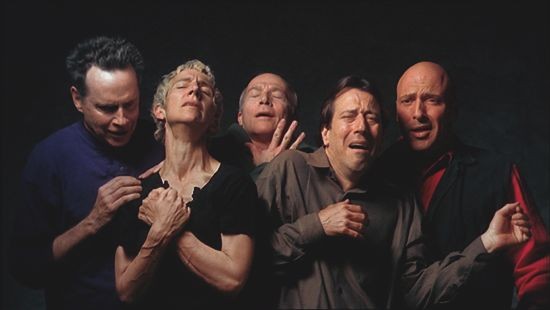
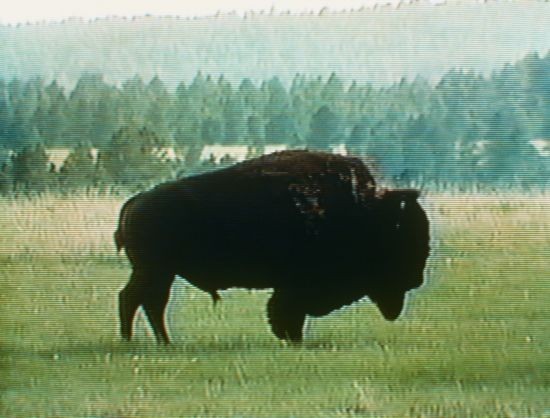
Top: The Quintet of the Astonished (2000), color-video rear projection on screen mounted on wall in dark room, projected image size 1.4 x 2.4 m, room dimensions variable, duration 15 min 20 sec. Performers: John Malpede, Weba Garretson, Tom Fitzpatrick, John Fleck, Dan Gerrity. Bottom: I Do Not Know What It Is I Am Like (1986), videotape, color, stereo sound, duration 89 minutes. Produced in association with the Contemporary Art Television Fund, Boston, and ZDF, Germany. Both: Photo Kira Perov.
ART iT: How does that relate to the expressions playing out in the images you create, which in may cases are very essential human expressions?
BV: Yes, they are archetypes. If without warning I suddenly clap my hands in front of your face – clap! – I can scare the shit out of you. And if I did it again – clap! – it’s not as strong, but I can still scare you. My Zen teacher used to do that. If he sensed the slightest bit of self-awareness in me, he would slap me right in the head – bang! – while we were talking, and I would be in shock, wondering what it was I had done.
This is an entirely other discussion and I don’t want to go too far, but Japan has given the world an amazing gift with Zen practice. The point of Zen practice, as I understand it, is to get the mind out of the way. The archer pulls the arrow and fires it, but if you ask him, he would say he hasn’t done anything; the arrow shoots itself. This intricate system that exists in practices like swordsmanship and archery is unified by the idea of getting rid of the mind – not in general, but the conscious mind, the one that’s right now calculating and assessing its situation. That’s the one that thinks, “Oh, I can do this, I can make a piece that will impress everybody.” If you get that out of the way, then you attain what Zen masters call emptiness, “no mind,” and that’s when you can be most pure in your actions.
The Japanese more than any other culture figured out a way to do that. Why? It comes from the samurai swordsman, the play between life and death. You make one false move and you’re dead, there’s no second chance. They had to develop this incredible system for bringing everything down to a fine edge of reality so they could defeat their opponents.
The relationship between time and expression follows. You can actually do something without doing it. The essential point is to get the conscious self out of the picture, so there’s no thinking involved.
ART iT: We had talked at the beginning about constructing images, or thinking about constructing images, so is this interest in time-form a different line of investigation from the works that deal more explicitly with human expression?
BV: I don’t know. At a certain point the works I was making became deeply connected with people, with humanity. As I mentioned, I lost my mother at the beginning of the 1990s and my father at the end of the 1990s, and those two events were disturbing and difficult to deal with. I realized how serious everything is. I realized that the life force is very fragile, and it changed my whole awareness of my experience in the world and what I can expect in the future – which is death – and my work came to be about people dealing with experience and what that means.
After The Reflecting Pool, there was also a body of work that focused on nature. I did a major, hour-and-a-half long piece on animal consciousness, I Do Not Know What It Is I Am Like (1986), for which I spent time with a herd of buffalo in Wind Cave National Park in South Dakota. I was trying to figure out what sentience is. When I started those works with myself or other people sitting in front of the camera and looking, I was actually exploring that without realizing what I was doing. What is consciousness? How can you experience the world? How do you reflect on it? How do you process it?
All that built up to recognizing that animals can think and see and have primitive emotions, which got me interested in animals and what they might be seeing and thinking. That was very important to do because it brought me out of the human mode and into visualizing or comprehending what life might be for other sentient beings. The Buddhists say that anything that has a life force is sentient, while the ancient Greeks thought stones could be alive. The question they asked was, what is alive and what is not alive? Whereas later Western culture comes along and asks, what has a mind? But then what is awareness? What is that point where you enter awareness, and what is that point where it disappears? When does something become an object? Sometimes it’s not so clear.
Bill Viola: Beyond Horizon
